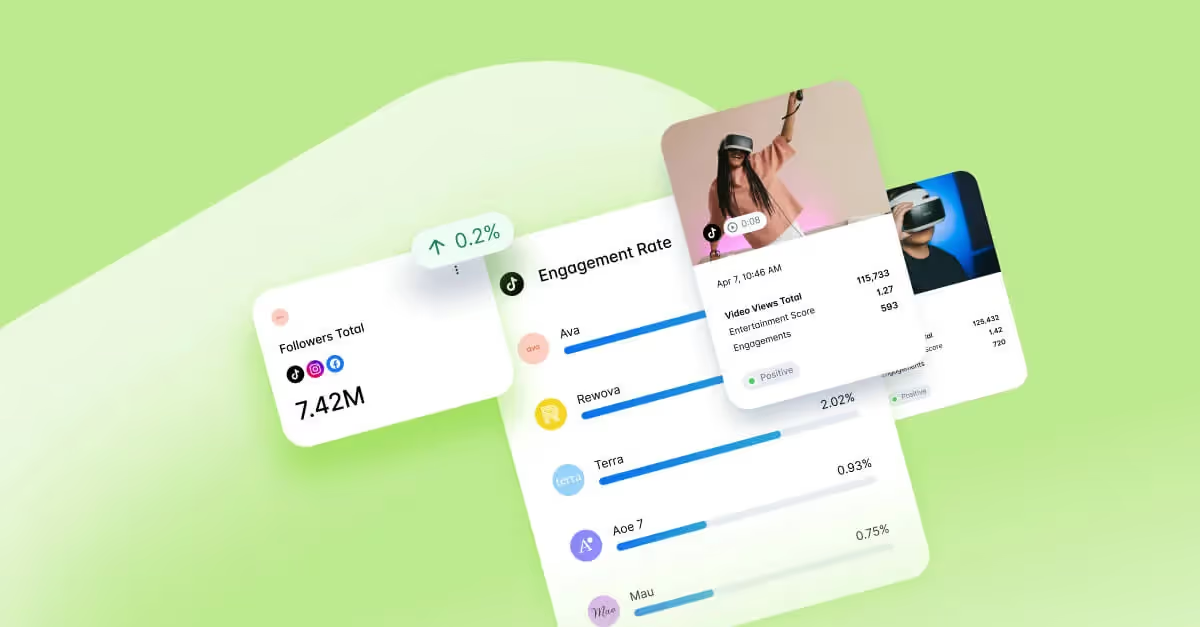26 Best Social Media Analytics Tools for Your Brand (2025 Comparison)
Explore the pros and cons of the most popular social media analytics tools.
.avif)
If you have a social media strategy, you need the right analytics tools to measure its impact. Social media analytics tools help track engagement, assess performance and refine your approach. They provide the insights needed to determine what’s working, optimize future campaigns and drive better results.
TL;DR:
- Social media analytics tools track and measure performance to show what works and where to improve
- The best tools go beyond basic metrics with insights into audience behavior, campaign impact and platform trends
- Competitive benchmarking features help brands compare performance to industry peers and find growth opportunities
- Platform-specific analytics reveal which channels drive the most engagement or conversions so resources can be allocated effectively
- Choosing the right tool depends on budget, reporting needs and the level of insight required to refine strategy
What Are Social Media Analytics Tools?
Social media analytics tools track, analyze and measure the overall impact of your social performance. These tools give your team insights into your overall strategy impact on various social media platforms (like Facebook, Instagram, Twitter, LinkedIn, etc.) These social media reporting tools go beyond basic metrics and offer your team detailed insights into social media KPIs such as audience demographics, engagement levels and content performance.
Common metrics tracked and measured include:
- Engagement rate
- Reach
- Impressions
- Shares
- Return on investment (ROI)
- Social ad spend
- Conversion rate
Whether you track follower growth, analyze post interactions or assess campaign outcomes, social media analytics help you optimize strategies for better engagement, growth and conversions.
Top 26 Social Media Analytics Tools
So, how do the most popular social media analytics tools stack up against each other? Whether you're a large enterprise with complex reporting needs or a small business with a tight budget, finding the right tool can make all the difference.
We've analyzed 26 of the top social media analytics tools, diving into hundreds of reviews from industry professionals like you to provide an unbiased comparison. With an impressive average G2 review rating and a median score of 4.5 out of 5, these are the best analytics tools for social media managers. In no particular order, let’s break it down.
1. Dash Social
Dash Social is an easy-to-use, visually focused social media analytics tool designed to help brands optimize content strategies through data-driven insights. Highly rated for its ease of use, analytics capabilities and customer support, Dash simplifies performance tracking without compromising on depth.
Known for its ability to analyze the visual performance of posts, Dash Social offers a unique feature called the Entertainment Score, which evaluates the engagement and retention of your content. Users can also track ROI, pinpoint the best times to post and monitor competitors’ performance across major platforms — all in one place.
Strengths:
“Dash is an extremely user-friendly tool providing in-depth analytics resulting in insights to inform best in class strategy. The various tools from dashboards to boards help my team and me analyze our social content in various ways, helping us master everchanging algorithms.” Source
Improvements:
“I wish we could pull more historical data, however I know that is usually a specific API issue.” Source
Best for: Fashion, beauty and retail industry brands that heavily rely on visual content
Trusted by: J.Crew, United Airlines, Unilever, Stella McCartney
Package options: Public tiered pricing
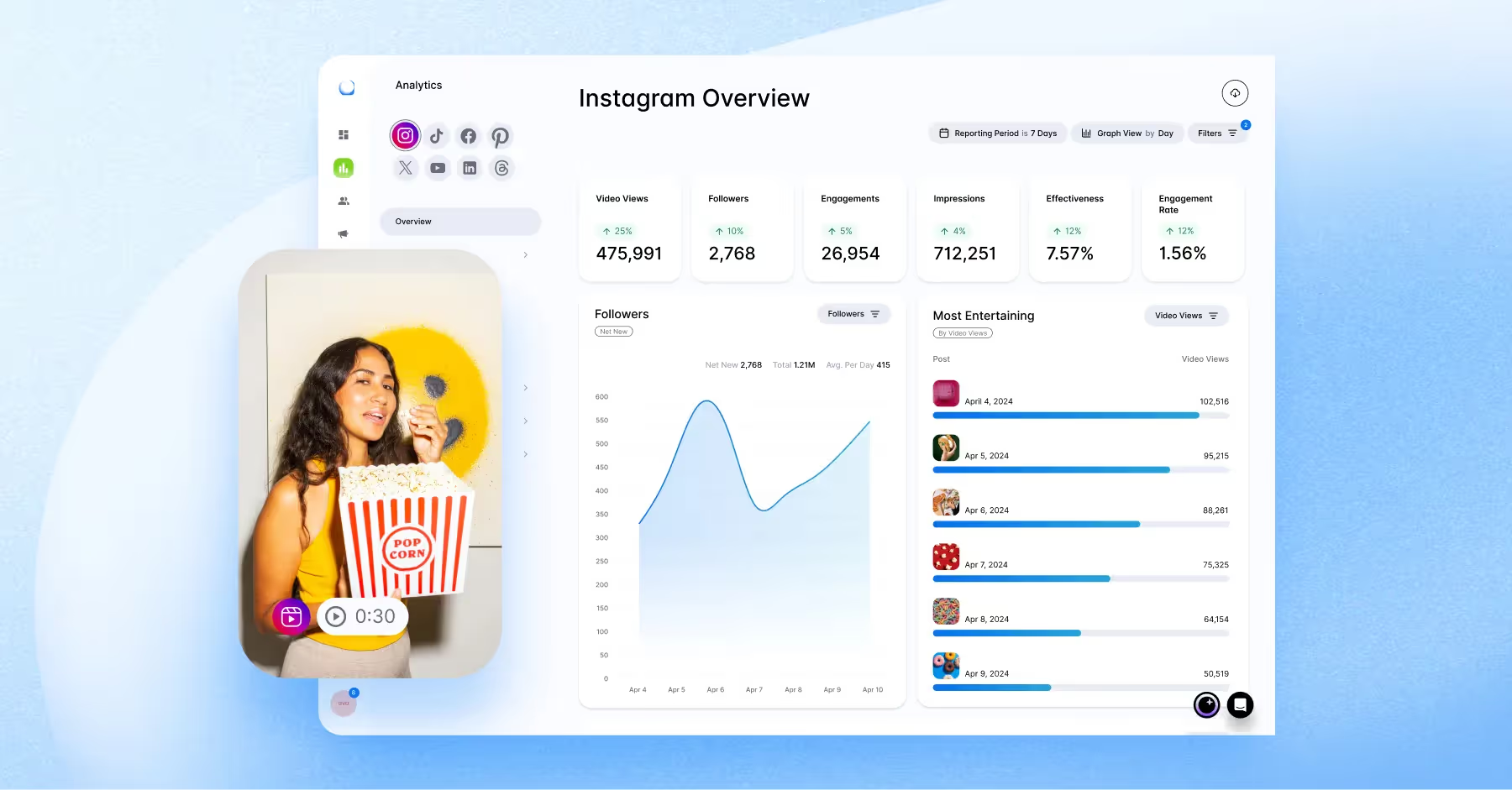
2. Zoho Social
Zoho Social is praised for its seamless multi-account management, allowing users to oversee all their social platforms from a single dashboard. Its automated posting and scheduling features help streamline content planning. However, some users mention limited integrations, mobile app issues and a lack of advanced analytics and reporting tools on the free or lower-tired plans. Still, Zoho Social is worth considering for those searching for a cost-effective and user-friendly solution.
Strengths:
“What I like best about Zoho Social is its comprehensive suite of tools that make social media management effortless. From intuitive content scheduling to insightful analytics, Zoho Social provides everything we need to maintain a strong and consistent online presence.” Source
Improvements:
“What I dislike about Zoho Social is the limited advanced analytics and the less robust mobile app. While the platform excels at basic metrics, it falls short when it comes to more sophisticated analytics like sentiment analysis or competitor benchmarking, which are essential for deeper strategic insights.” Source
Best for: Small businesses, limited budgets
Package options: Free and public tiered pricing
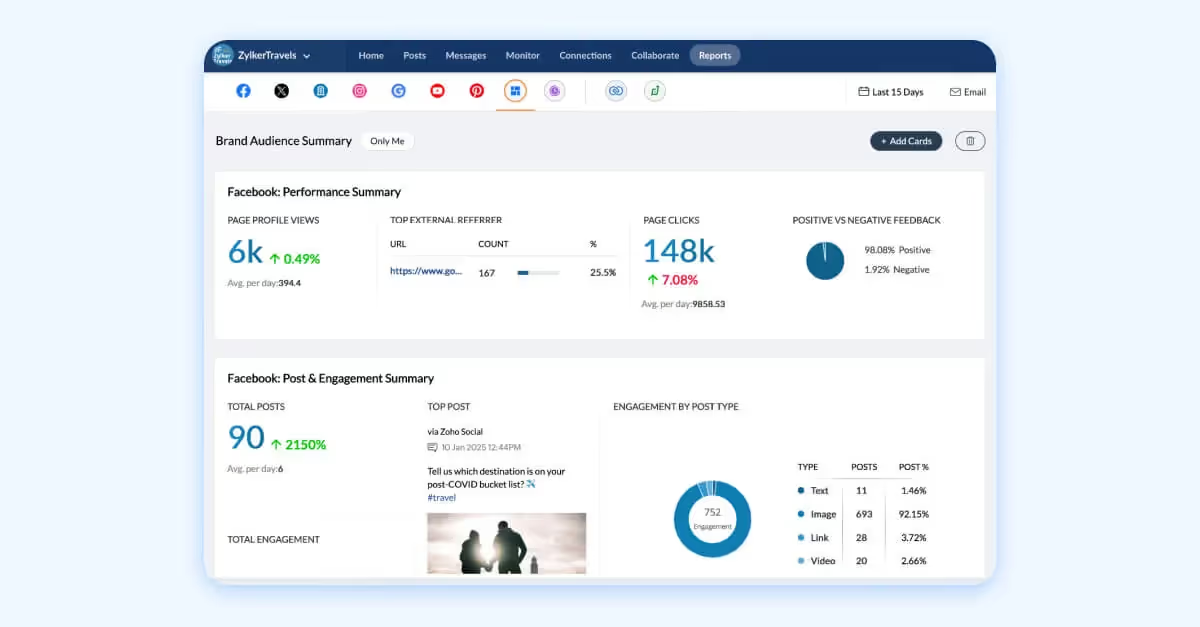
3. Social Status
Social Status is an analytics tool specializing in advanced reporting for organic, paid and influencer campaigns. With competitive benchmarking features, brands can easily compare their performance against industry peers, gaining insights to refine their strategy. Users frequently praise its detailed reporting and highly rated customer service.
However, some reviewers note limited customization in reports and mention that it lacks certain advanced features found in other social media marketing tools. Additionally, setting up reports and downloading data can be time-consuming. Despite these drawbacks, Social Status remains a good option for brands focused on in-depth campaign analysis and competitive insights.
Strengths:
“The pricing is fair, and I like the fact that I can switch between subscriptions.” Source
Improvements:
“I would love if I had more flexibility when it comes to choosing the KPIs for the reporting.” Source
Best for: Limited budgets, marketing agencies and freelancers
Package options: Free and public tiered pricing
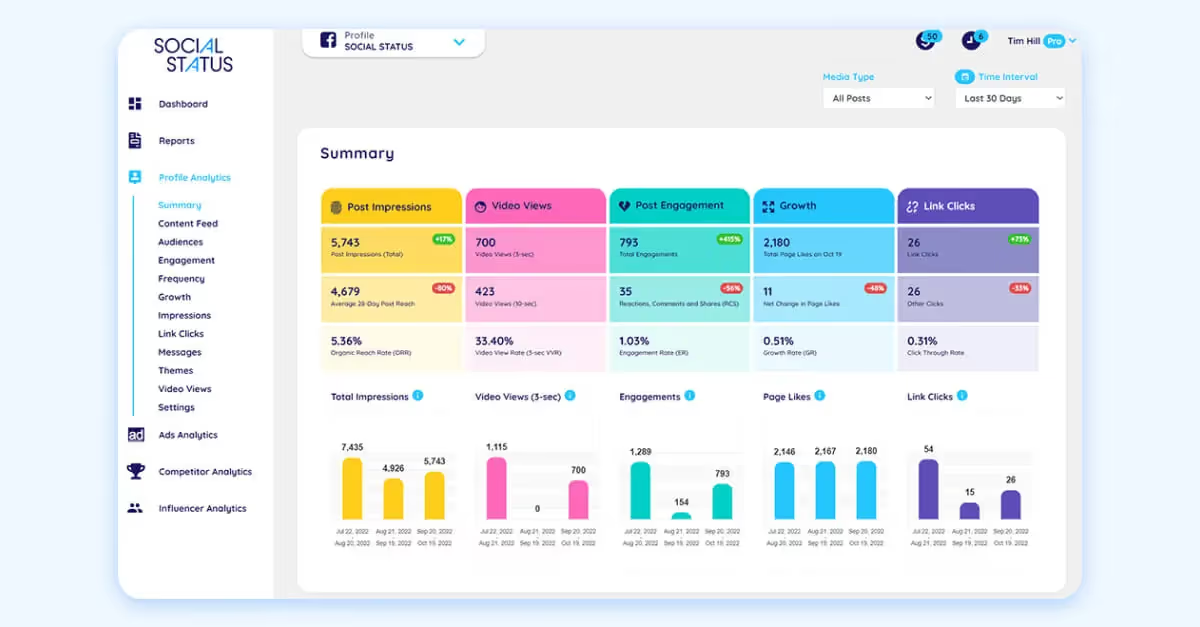
4. Vista Social
Vista Social combines analytics, scheduling and automation tools in a clean and intuitive platform. Users appreciate its affordable pricing plans, easy post scheduling and engagement monitoring. However, some reviewers note that in-depth analytics are limited and certain features require higher-tier plans.
The mobile app also needs improvement for better report accessibility. Still, for businesses seeking a budget-friendly social media reporting tool, Vista Social is a good option.
Strengths:
“It has features that stand out; the integration which makes it super easy to link with top social media network profiles from a centralized dashboard. With Vista Social, you can also get detailed analytics, which has helped me identify and make necessary improvements.” Source
Improvements:
“The setting up process at the start felt a bit overwhelming due to a number of features to navigate. I'd recommend getting guidance to help you in the onboarding process...” Source
Best for: Small businesses and freelancers
Package options: Free and public tiered pricing
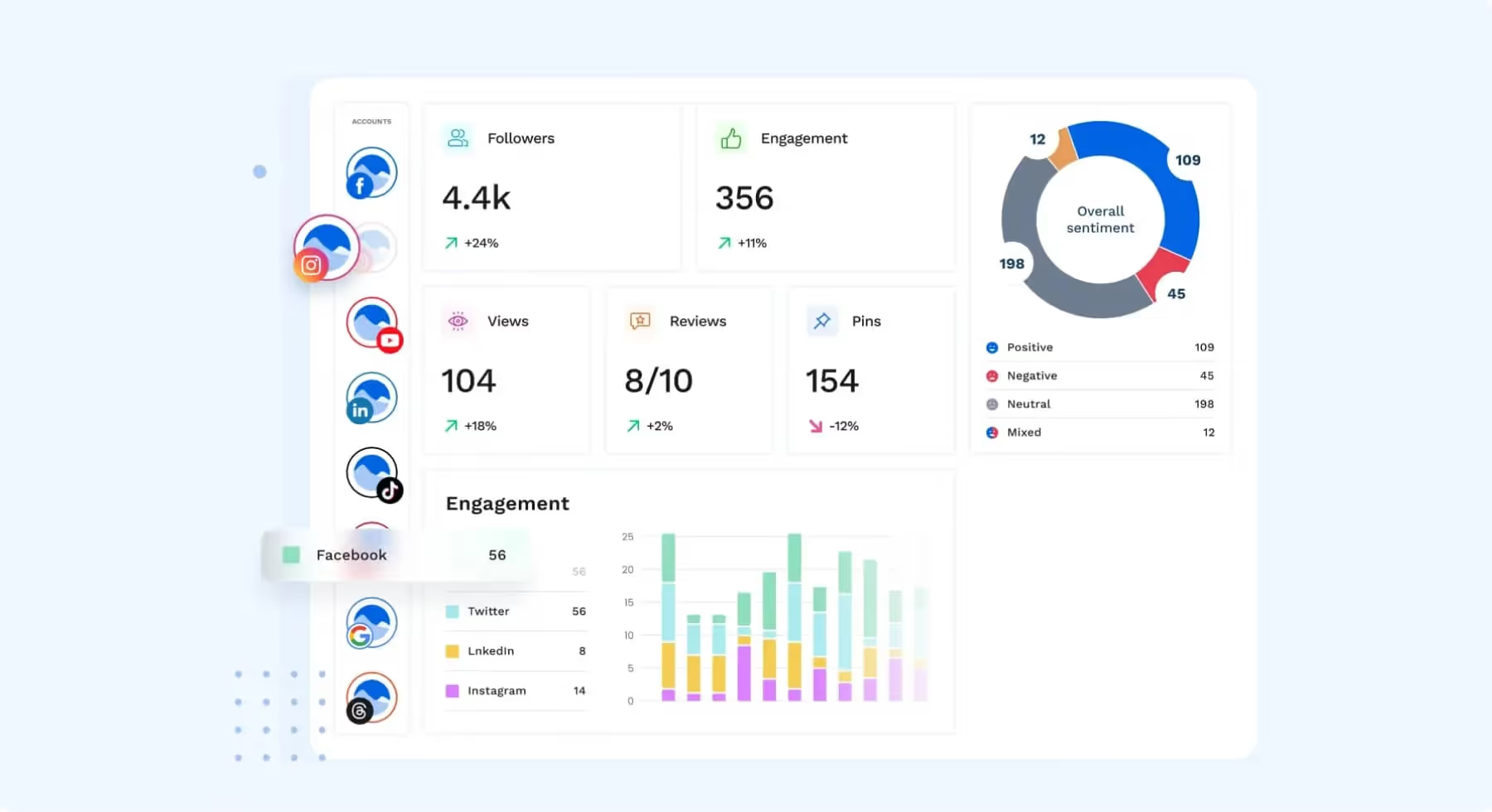
5. Hootsuite
Hootsuite’s integration with multiple social platforms makes it a powerful tool for analyzing and optimizing your social media strategy. With customizable reports, you can gain insights into engagement, audience growth and content performance. However, while Hootsuite’s advanced analytics features are robust, they can come at a higher cost and the learning curve may be steep for new users. Still, for social media managers looking for a comprehensive solution, it remains a top contender.
Strengths:
“The analytics tools offer valuable insights, helping me improve engagement.” Source
Improvements:
“I feel the reporting and analytics can be fiddly to zero in on what exactly I am looking for, but access to their training pages and customer support has helped balance this out.” Source
Best for: Enterprise brands and marketing agencies
Package options: Public tiered pricing

6. Agorapulse
Agorapulse streamlines content scheduling, analytics and customer support in one platform. Users love its content calendar and comprehensive analytics tools. The platform is praised for its reliable customer support. However, some reviewers have reported occasional bugs and difficulties with the sign-in process.
Additionally, the cost of adding extra profiles can be high. In spite of these challenges, Agorapulse is still a good alternative for businesses looking for a well-rounded, data-driven social media management solution.
Strengths:
“Navigating through its broad array of features is surprisingly easy, making it a go-to platform for both beginners and seasoned professionals. From analytics to collaboration tools, Agorapulse combines simplicity with functionality, making social media management a joy.” Source
Improvements:
“While Agorapulse excels in user-friendliness, its limitations become apparent in reporting functions, especially at lower subscription levels. Users might find themselves desiring more comprehensive analytics.” Source
Best for: Small businesses, limited budgets
Package options: Free and public tiered pricing
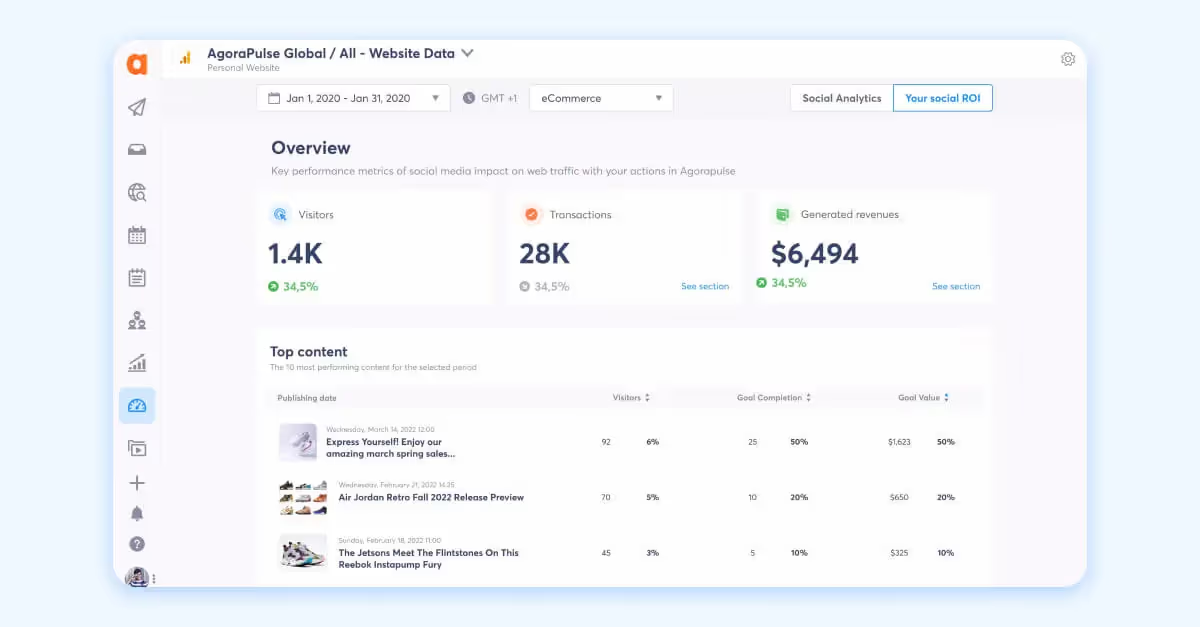
7. Rival IQ
Rival IQ is designed to maximize engagement through competitive benchmarking, automated insights and a robust set of social media metrics. Users appreciate its easy-to-use interface, which ensures a cohesive experience for marketers of all skill levels and its ability to pull competitive metrics. However, some reviewers mention that pricing may be high for smaller brands and the platform offers limited integrations compared to other tools. Despite this, Rival IQ continues to rank among the top social media reporting tools.
Strengths:
“I appreciate that Rival IQ offers me stats and tables for metrics that I may not have previously considered a being instrumental pieces of data. However, there have been a handful of times where I've looked at some of these different graphs and have been able to see trends that I wouldn't have noticed if I was just looking at the big stats like Engagement Rate per follower.” Source
Improvements:
“The aesthetic appeal and the lack of ability to customize it much makes me less excited to use the built-in tables and graphs that you can just export. Even though that would be a lot more convenient, I prefer to design my own graphs so that they look as clean and beautiful…” Source
Best for: Enterprise brands and marketing agencies
Package options: Public tiered pricing
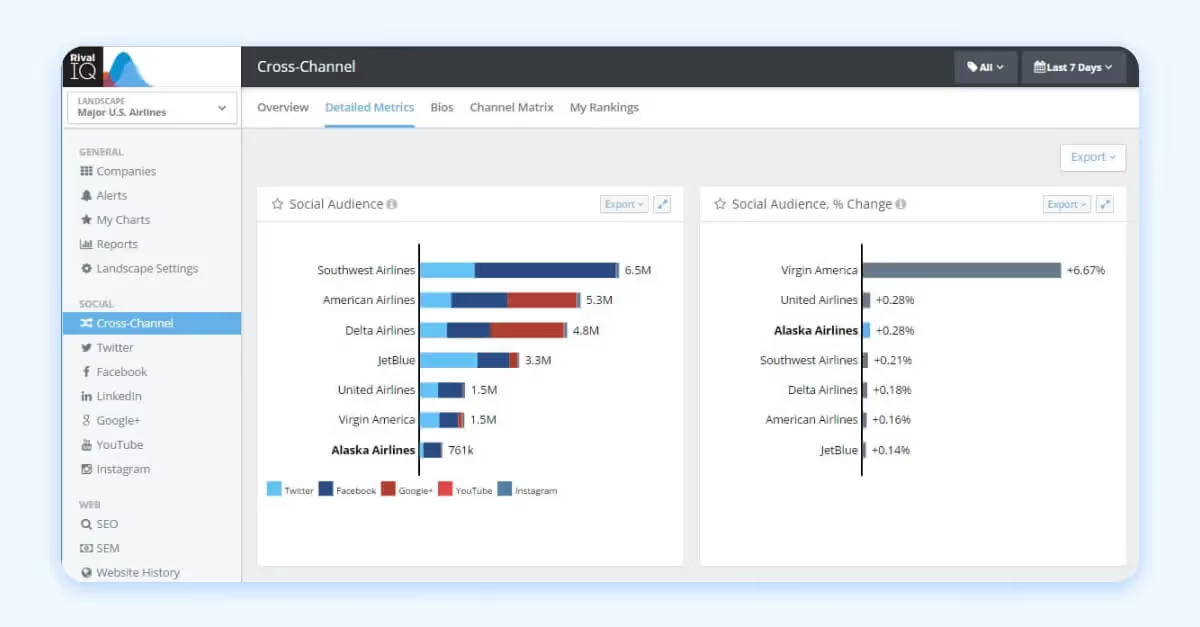
8. Eclincher
Eclincher helps businesses, agencies and brands track performance and optimize their digital presence. Offering integration across major social networks like Facebook, Instagram, LinkedIn and TikTok, it provides a centralized dashboard for managing multiple accounts and analyzing key social metrics. Users appreciate its ease of use and responsive customer service, making it a solid choice for teams looking for an intuitive analytics solution.
On the downside, some reviewers report occasional bugs and slow performance, noting that the platform could benefit from further improvements. Regardless of these shortcomings, Eclincher remains a great option for brands.
Strengths:
“As a social media manager and content strategist, Eclincher does well to cover its bases of channel connectivity and reach. It's great for its built-in analytics and visualization to help pinpoint segment data -- hands down the best part of this product.” Source
Improvements:
“The deal breaker with Eclincher which precipitated our move was how cumbersome it was to get support operators that were real people. Moreover, the pricing structure changes priced itself out of competing brands that offered more bells and whistles and faster customer service reps.” Source
Best for: Small to mid-market businesses and marketing agencies
Package options: Public tiered pricing
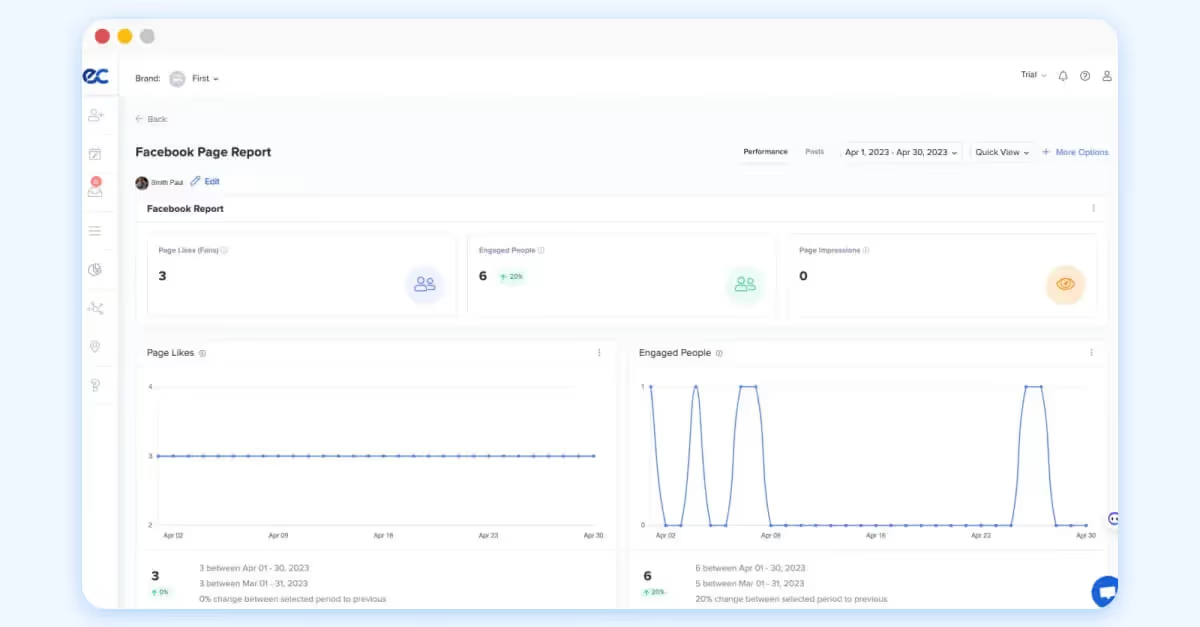
9. Iconosquare
Iconosquare provides comprehensive insights to help businesses track performance and optimize their social media strategies. Users appreciate its detailed analytics and competitor benchmarking features, which allow brands to measure their success against industry peers. The intuitive interface makes navigating reports and metrics simple and accessible for users of all skill levels.
However, some reviewers note that pricing can be high, integration options are limited and customer support response times can be slow. Despite these drawbacks, Iconosquare remains a strong choice for businesses looking for in-depth social media performance analysis.
Strengths:
“The analytics are so comprehensive and easy to understand.” Source
Improvements:
“...wish it had more uses - like project and content planning.” Source
Best for: Mid-to-large businesses and marketing teams
Package options: Public tiered pricing
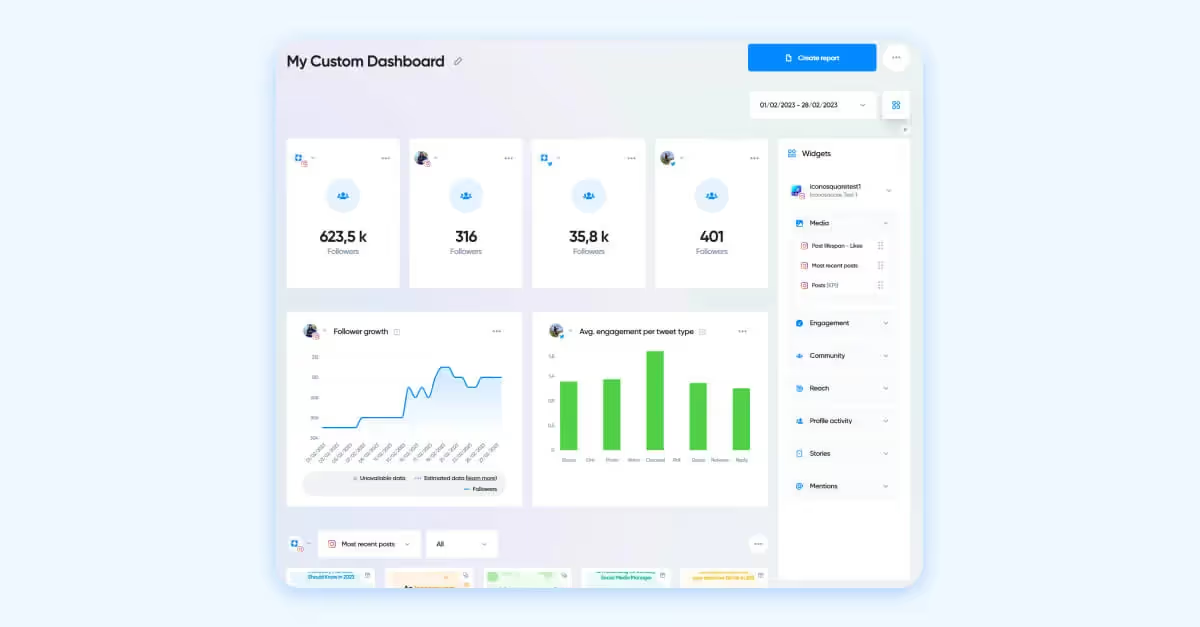
10. SocialPilot
A streamlined social media analytics solution, SocialPilot gives businesses and marketers the tools to track performance and maximize efficiency. Its comprehensive analytics provide insights into content reach and audience interaction. Managing multiple accounts? No problem. Users praise SocialPilot’s simple platform, making scheduling and analysis a breeze.
But no tool is without flaws. Some users mention limited report customization, an occasional need to reverify logins and the inability to post to regular Instagram accounts as areas for improvement. Considering everything, SocialPilot remains a top choice for brands looking for efficient social media performance tracking.
Strengths:
“Implementation was super easy and the integration was a breeze. We use it every day in our roles for the agency and the customer support has been top-notch.” Source
Improvements:
“The only complaint we have about the tool would be the analytics function. It doesn't always match the source and we find the results skewed. We also often can't get all of the data we are looking for through the tool and have to go to the source anyway.” Source
Best for: Small businesses, limited budgets
Package options: Public tiered pricing11. Metricool
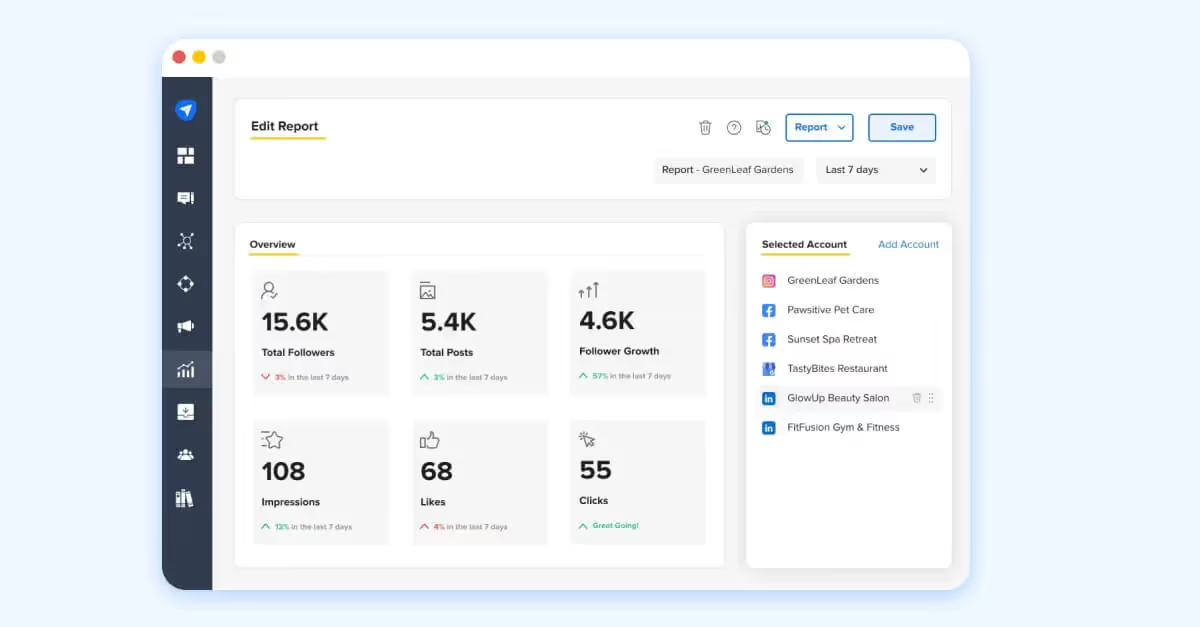
11. Metricool
Metricool excels in analytics, audience engagement insights and competitor benchmarking. Users appreciate its scheduling tools and detailed competitor analysis, making it a smart pick for brands.
However, smaller plans come with limited analytics and some users find the platform difficult to navigate. Additionally, customer support reviews are mixed, with some users reporting a lack of responsiveness. If customer service isn’t a deal breaker for you, Metricool might be a good option.
Strengths:
“Being able to look at analytics for the brand in one platform saves so much time!”
Improvements:
“I wish there was a way to combine the data for both brands so you can see how well YOU are doing as a social media manager. Also, I wish there was a way to compare results of 'campaigns' rather than individual posts.” Source
Best for: Freelancers, marketing agencies and small businesses
Package options: Free and Public tiered pricing

12. Sendible
Sendible’s analytics tools help businesses track performance across multiple social platforms, offering insights into engagement, reach and audience growth. Users love its clear and organized UI and responsive customer support, making it a great option for those managing multiple accounts.
However, some users find that advanced features are only available on higher-tier plans and there can be a learning curve when getting started. While Sendible offers a strong all-in-one solution, it’s worth considering these factors before making your decision.
Strengths:
“Easy to connect and get reports quickly for your social posts and engagements.” Source
Improvements:
“Sendible provides a lot of benefits but here are some points to be noted
1. For bigger organizations the white label subscription is costly.
2. Managing and analyzing all data can be challenging sometimes.” Source
Best for: Small brands and marketing agencies
Package options: Public tiered pricing
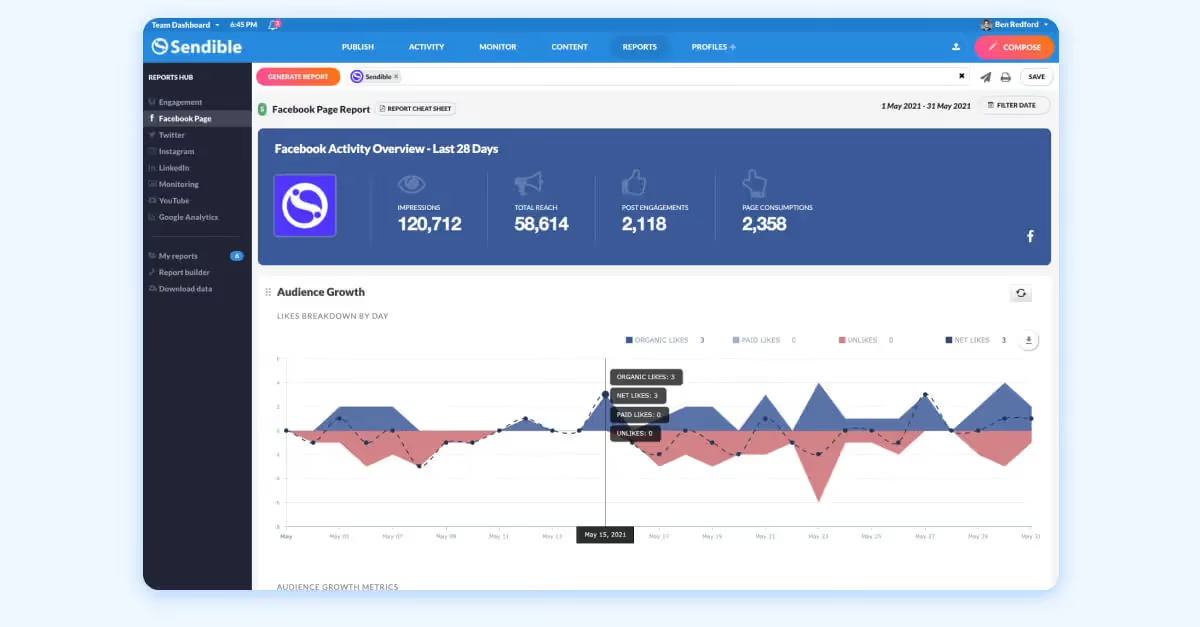
13. Sprout Social
Sprout Social offers detailed audience insights and advanced reporting options, making optimizing social strategies seamless. Its social listening features allow brands to monitor conversations, track social media trends and better understand their audience. Users often mention its easy-to-use platform and robust data analysis as top benefits.
However, Sprout Social's premium features come at a higher price, which may be challenging for smaller businesses and its free plan offers limited functionality. Still, for teams that prioritize in-depth analytics and social listening tools, Sprout Social might be a strong option.
Strengths:
“The analytics are very robust and overall so simple to navigate. Love that you can separate paid vs. organic performance as well as compare from one time period to another.”
Improvements:
“As granular as the analytics/reporting feature is, it is frustrating that you cannot view profile performance for organic only. I understand this is likely a limitation at the platform/API level, but I wish there was better reporting for organic.” Source
Best for: Enterprise to mid-market brands and marketing teams
Package options: Public tiered pricing
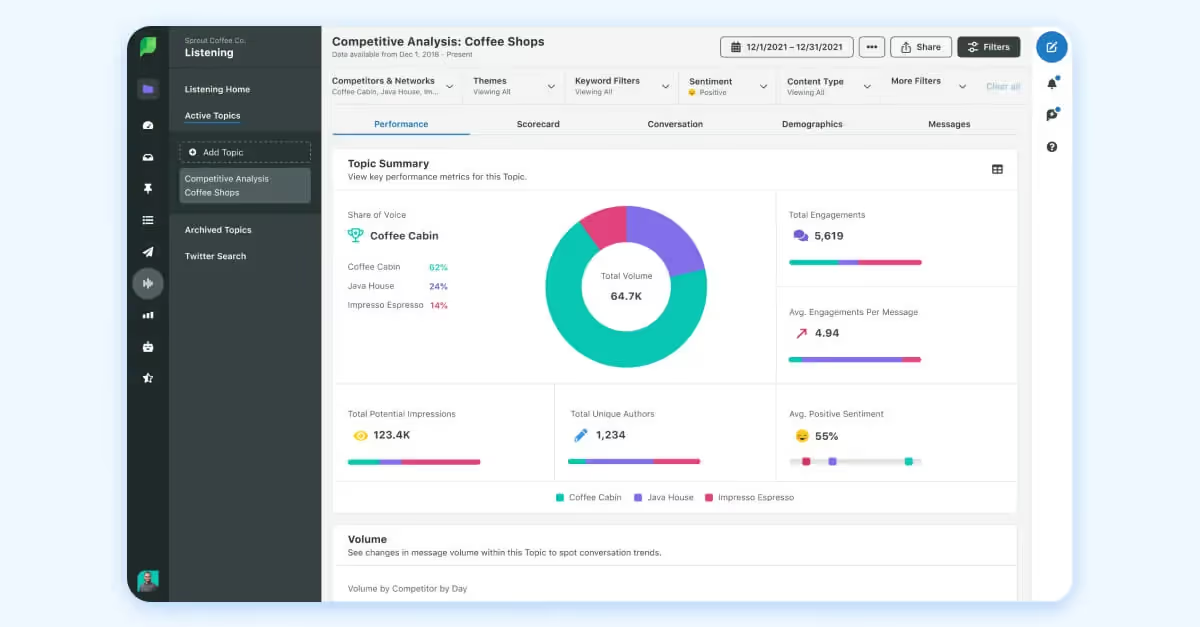
14. Brandwatch
Formerly known as Falcon.io, Brandwatch offers a powerful all-in-one platform for social media monitoring, publishing, advertising and audience analytics. Users appreciate the convenience of linking all their social accounts in one place and the flexibility to customize setups for different strategic goals.
However, some have reported issues with the platform's glitchiness, slow customer support and steep learning curve due to its extensive features. While these aren’t necessarily deal breakers, they’re important considerations when evaluating whether Brandwatch fits your needs.
Strengths:
“Brandwatch was fairly user friendly. I liked all of the analytics capabilities and felt that it did a good job with all of the different reporting capabilities.” Source
Improvements:
“It sometimes felt like it took a lot of manual work to find what we were looking for in Brandwatch. We often get one-off requests that we need to find insights quickly for, so this was sometimes a struggle.” Source
Best for: Mid-market and small-business
Package options: Public pricing is not available

15. Talkwalker
Talkwalker is a social media analytics tool known for its advanced data visualization, in-depth social listening and analytics and responsive customer support. Users appreciate its customizable dashboards and deep insights into social trends.
Similarly to other tools on this list, some find the learning curve steep, the pricing high and have reported occasional glitches. If you're a brand working with a limited budget, these factors are worth considering before making a decision.
Strengths:
“Robust visualization and drilldown capabilities make it easy to share the data to stakeholders internally and externally.” Source
Improvements:
“It can still be rough around the edges. Some error messages are difficult to decode.” Source
Best for: Enterprise to mid-market brands and marketing teams
Package options: Public pricing is not available
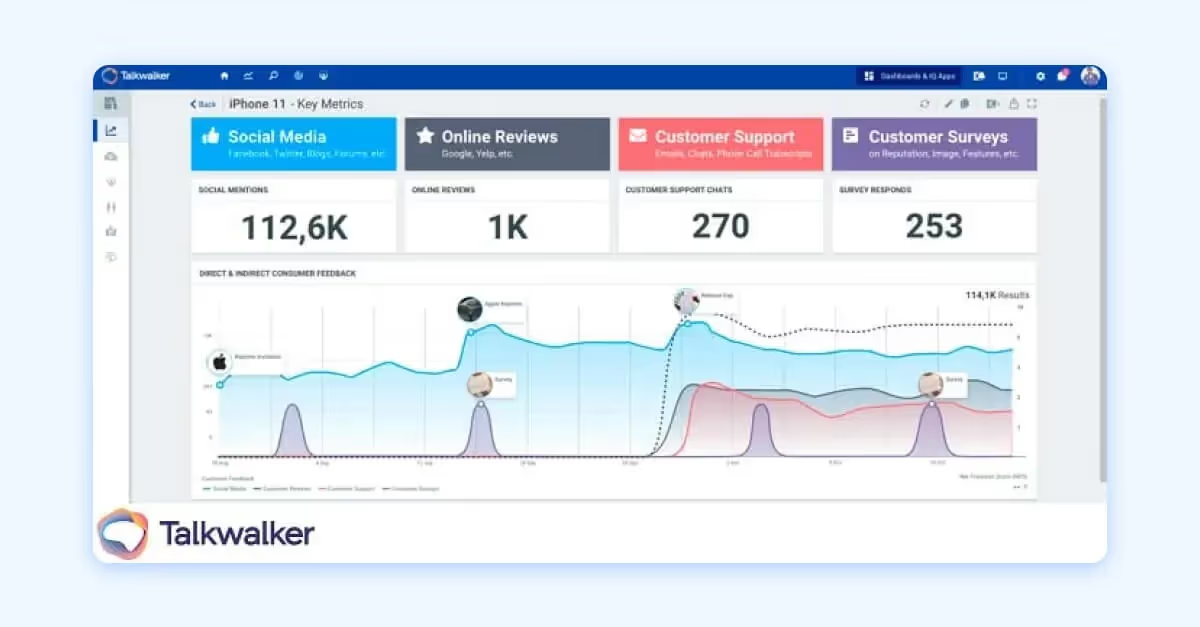
16. Buffer
Buffer is a great option for smaller brands and individuals looking for a straightforward way to plan and publish social media content. Some users find its analytics lacking in depth, with only basic performance insights available on the free version. There have also been reports of occasional glitches and a learning curve for advanced features if you’re on a higher tired plan. While Buffer excels at simplifying social media scheduling, those needing comprehensive analytics may want to explore additional tools.
Strengths:
“The analytics are great that show the performance of each post and also buffer is pretty affordable.” Source
Improvements:
“Instagram is not supported well in the basic plan.” Source
Best for: Small brands or marketing agencies
Package options: Free and Public tiered pricing
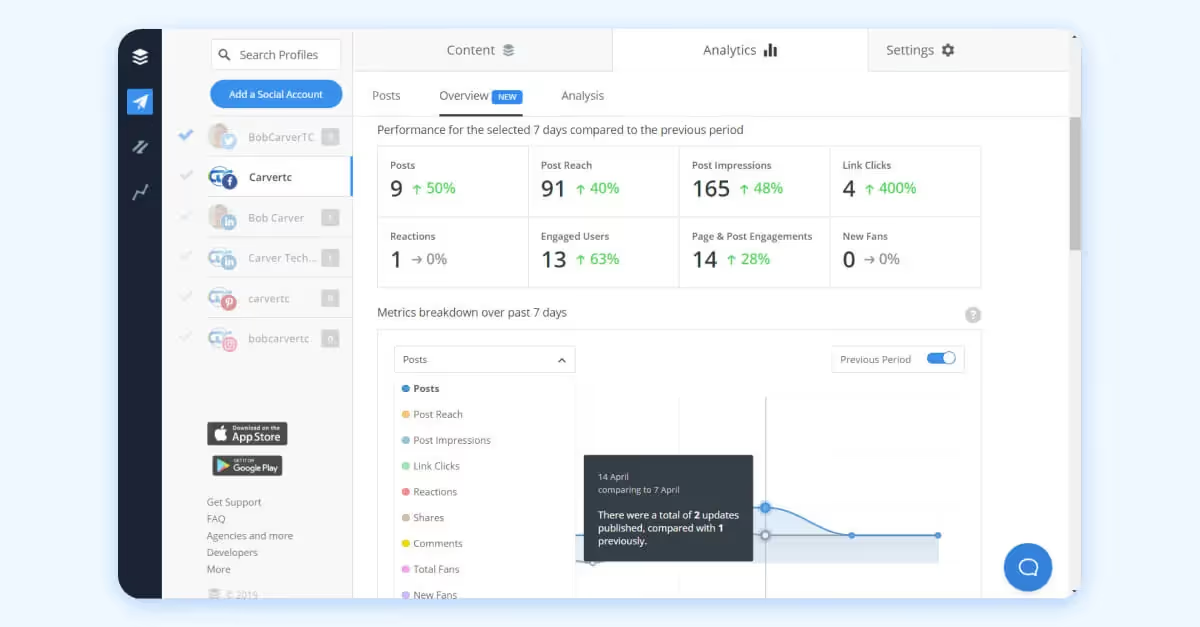
17. Keyhole
Keyhole is a user-friendly social media analytics tool known for its strong hashtag tracking and influencer identification capabilities. It's easy to use for everyone, no matter their experience level. However, some reviewers find the pricing to be on the higher side and note that it lacks certain advanced features compared to competitors, depending on your package. While Keyhole is a great choice for brands focused on hashtag analytics and influencer tracking, those with more complex analytics needs or limited budgets may want to consider other options.
Strengths:
“My use of Keyhole is purely for tracking campaigns. I like that we can get granular in the settings as to what we are looking for and the breakdown of the info it provides.” Source
Improvements:
“I'm not entirely sure how accurate the information is because when I compare the analytics to another reporting system, they don't typically align.” Source
Best for: Enterprise to mid-market brands
Package options: Public pricing is not available
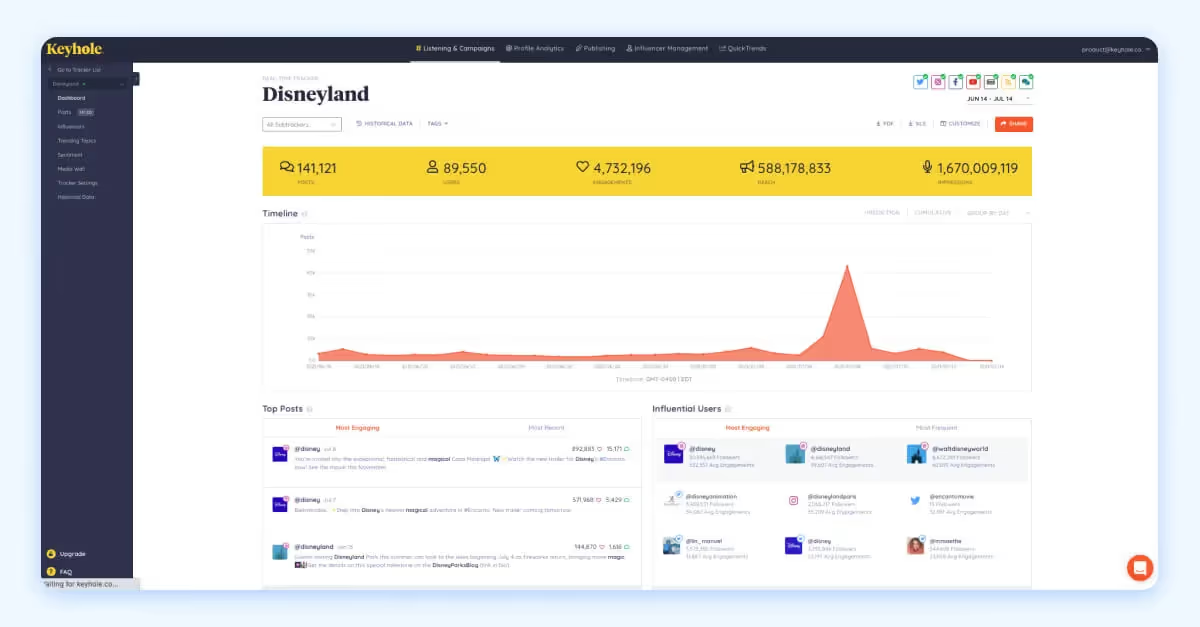
18. Meltwater
Meltwater is built to help users monitor public perception, analyze industry trends and track competitor insights. Reviewers highlight its strong tracking capabilities, in-depth analytics and responsive customer support, making it a valuable tool for communications teams and executing PR strategy. However, some users find the interface challenging to navigate and, like other platforms, experience occasional glitches.
Additionally, its higher price point and limited coverage of certain platforms may be drawbacks for some. While Meltwater excels in media monitoring, it might not be the right fit for brands looking for a comprehensive social media analytics tool.
Strengths:
“We love the ability to track trends and keep track of what competitors are doing, and the benchmarking capabilities.” Source
Improvements:
“We don't love having to pay separate for an API integration that allows our data and analytics team to connect directly to the platform. The database of reporters could be a little bit more robust, but it is sufficient for our needs.” Source
Best for: Small businesses and PR and communication teams
Package options: Public pricing is not available
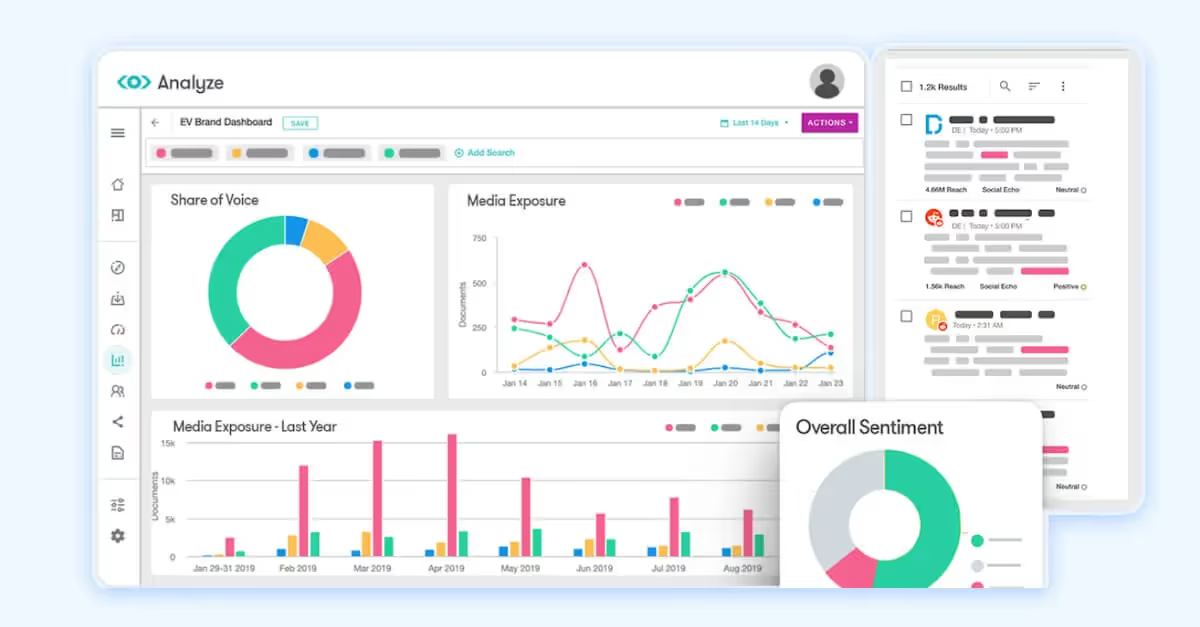
19. Brand24
Brand24 focuses on tracking online mentions and brand presence across platforms. Reviewers often praise its ease of use, social listening capabilities, and responsive support. However, some note gaps in advanced features, and access to LinkedIn analytics and YouTube monitoring is limited to higher-priced packages. Pricing can also be a hurdle for smaller teams, so brands on tight budgets may not find it the most cost-effective option.
Strengths:
“I appreciate that it gathers data not just from social media but from all public sources, giving me a genuine overview of how my brand is doing, beyond just what people are saying about my product.” Source
Improvements:
“You have to pay for more expensive plan if you want to monitor YouTube and LinkedIn.” Source
Best for: Enterprise to mid-market brands and marketing agencies
Package options: Public tiered pricing
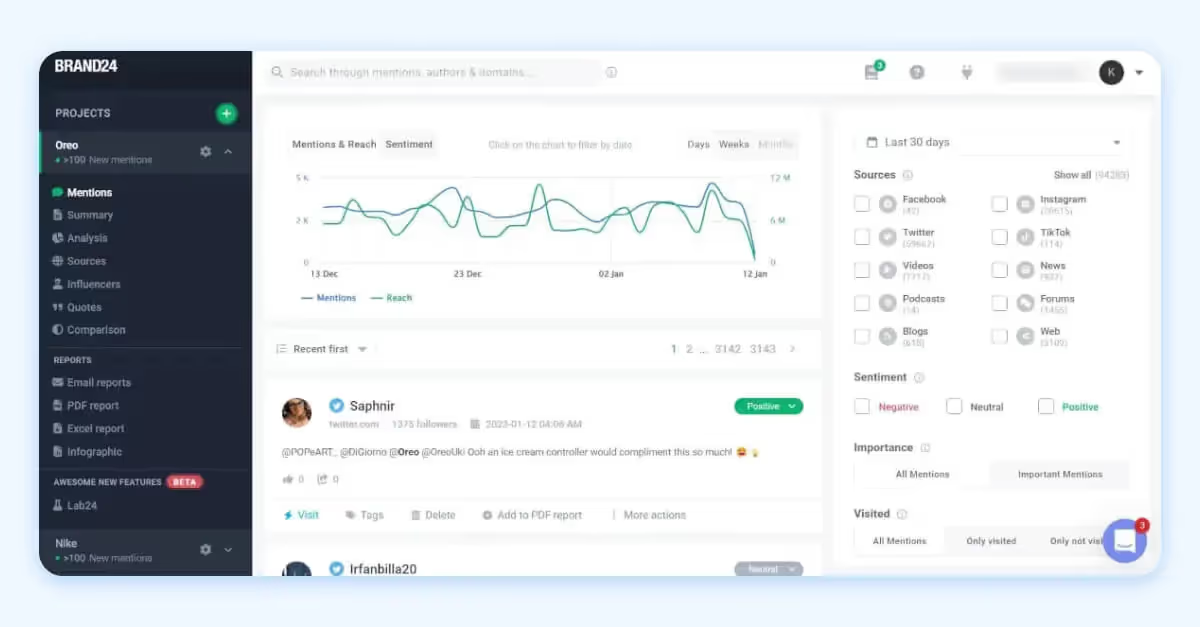
20. SOCi
SOCi is an AI-driven marketing platform ideal for multi-location businesses, offering tools to manage social media, reviews and local listings. Users appreciate the dashboard design, centralized management capabilities and customer support. At the same time, some find the platform lacks flexibility for more tailored strategies and its pricing may be a concern for smaller businesses.
Additionally, with limited advanced analytics and a higher price point compared to competitors, these factors could be potential deal-breakers when evaluating SOCi as a solution.
Strengths:
“It makes scheduling content easier and more efficient and the analytics provide useful insights to help guide decisions.” Source
Improvements:
“I find SOCi to be a bit rigid in its functionality. It doesn’t offer the flexibility I need to manage social media effectively. Some features feel limiting, and I often find myself wishing for more robust capabilities. It also seems to lack certain key tools that would enhance its usability and make it more effective for day-to-day management.” Source
Best for: Franchise or multi-location businesses
Package options: Public pricing is not available
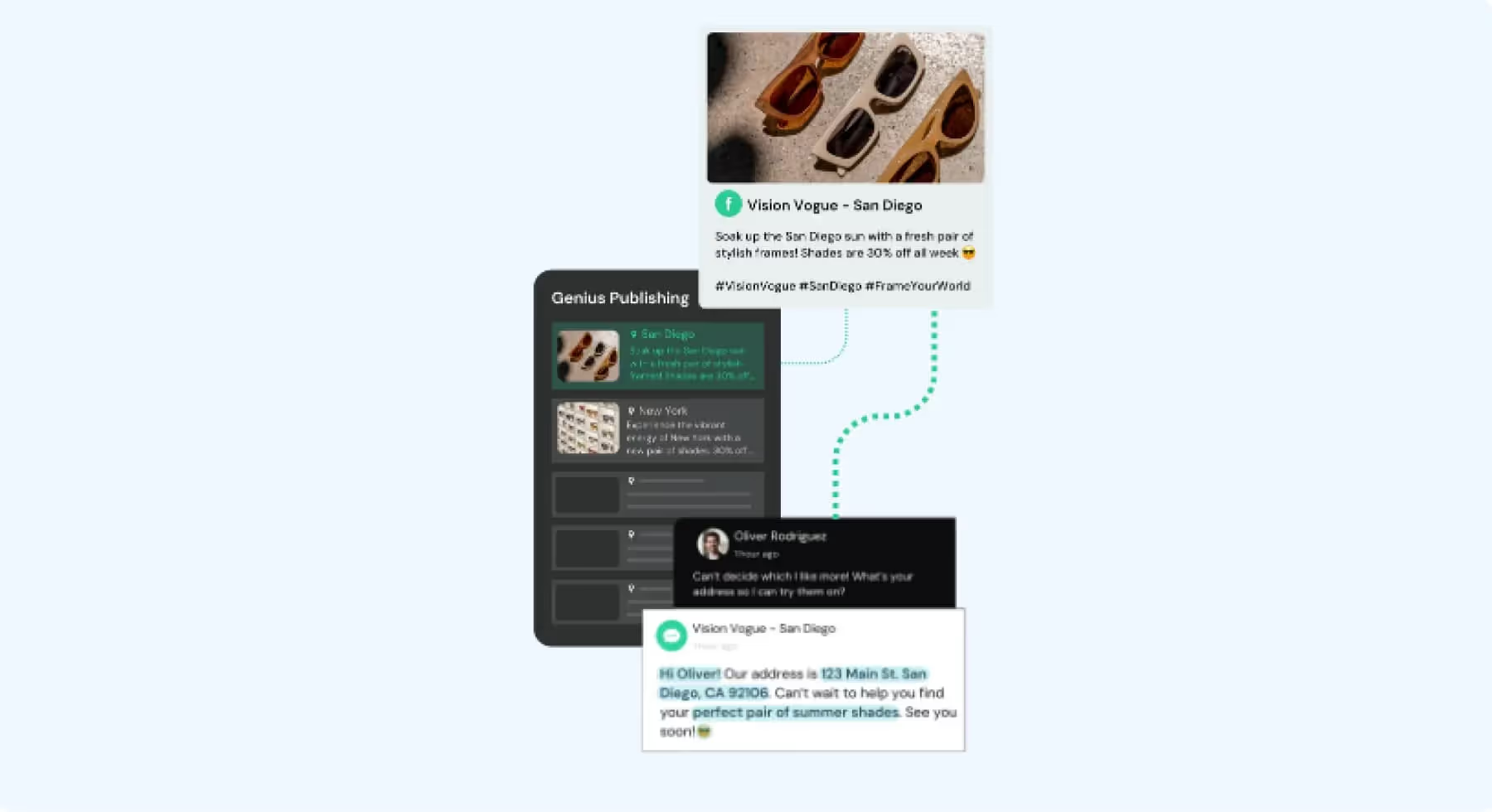
Native Social Media Analytics Platforms
While third-party tools offer advanced insights, competitive benchmarking and deeper audience analytics, many social media platforms provide their own budget-friendly, built-in analytics tools. These native analytics solutions give users direct access to performance metrics, such as engagement rates, audience demographics and content performance.
However, native analytics come with common limitations, including restricted historical data access, lack of cross-platform insights and limited reporting flexibility. In the next section, we’ll explore how native social media analytics tools compare, their strengths and where they may fall short.
21. TikTok Analytics
TikTok's native analytics tool is called TikTok Analytics and it’s accessible through the TikTok Business Center and the Creator Tools section within the TikTok app. TikTok's native analytics provide a cost-effective and easy way for users to track essential performance metrics, like total interactions, follower growth, demographic data and how many people visit your profile.
Other key features of TikTok’s native analytics platform:
- For video performance, get insights into views, likes, comments and shares for individual videos. Keep tabs on how long viewers watch your videos on average and see the total watch time for specific content.
- For trend analysis, check out your top-performing content over a given time period to see what’s resonating. For lower-performing content, see the percentage of video watched before viewers drop off.
- TikTok Live analytics shows the total number of people who joined the live (total views) and the number of individual accounts that joined (unique views). How long people watched, the number of followers gained during the live and your earnings from virtual gifts received.
- TikTok ad performance tracks the number of people who saw and clicked on your ad, the conversion rate, cost per click (CPC) and return on ad spend (ROAS).
While these built-in tools offer a solid starting point for understanding content performance, they come with limitations, such as restricted historical data access (up to 60 days) and limited customization options for deeper insights. Users can only monitor content and audience engagement over 7-day, 28-day or 60-day periods, which may not be sufficient for long-term trend analysis.
If your TikTok marketing strategy requires more advanced TikTok analytics, insights, competitive benchmarking or the ability to analyze performance data beyond a two-month window, third-party analytics tools may offer a more comprehensive solution.
22. Instagram Analytics
Instagram’s native analytics, also known as Instagram Insights, is free and easy to use. It tracks performance metrics across posts, Stories and Reels, as well as profile data, helping brands understand their account performance.
- For posts, native Instagram analytics provides insights into reach, impressions, engagement rates, profile visits and saves, allowing marketers to assess static content performance for up to 90 days.
- Stories analytics track exits, taps forward and backward, replies and link clicks, offering data on how viewers interact with short-lived content but only for up to 14 days. After this period, the data is no longer accessible within the platform.
- Reels analytics focus on plays, watch time, interactions, shares and saves, helping brands measure video engagement and content effectiveness. Like posts, this data will only be available for up to three months.
While these insights provide a good snapshot for understanding audience behavior right now, Instagram’s built-in analytics have limitations, such as restricted historical data access and a lack of customizable reporting. For brands and marketers looking to supercharge their Instagram growth, third-party tools may offer a more comprehensive solution.
23. Facebook Analytics
Facebook’s native analytics tool, Facebook Insights, gives page administrators access to key performance metrics, audience demographics and engagement data to help optimize their content marketing strategy. From tracking post reach and interactions to analyzing page views, actions and audience insights, Facebook provides a detailed view of how content resonates with users.
- The overview dashboard displays a summary of page performance, including metrics like page likes, post reach and engagement over selected timeframes.
- Post-performance offers detailed analytics on individual posts, highlighting metrics such as reach, clicks, reactions, comments and shares.
- Audience insights provide demographic information about your followers, including age, gender, location and language, aiding in content tailoring.
- Page views and actions track the number of views your page receives and the actions taken by visitors, such as clicking on contact information or website links.
However, when it comes to data retention, Facebook Insights has limitations. Users can export data in chunks of up to 180 days, meaning multiple exports are required for longer-term social media analysis. Additionally, Facebook has not explicitly detailed how far back page insights data is retained, making historical data access inconsistent.
Overall, Facebook Insights offers a lot of performance metrics, but for more advanced analysis and extended data retention, brands focused on developing a strong Facebook marketing strategy might consider bringing on a third-party analytics platform.
24. Pinterest Analytics
Pinterest’s native analytics tool, Pinterest Analytics, provides insights into engagement, saves (repins), Pin clicks and audience demographics, helping businesses assess how well their content performs. Users appreciate its ability to track impressions and conversions. However, some find the platform lacks advanced customization options for in-depth reporting and its interface can be complex to navigate.
Users can monitor and analyze their content's performance over customizable timeframes, such as daily, weekly or monthly. However, Pinterest's official documentation does not explicitly provide specific details regarding the maximum duration for which historical analytics data is held, so this may vary by account.
Here are some examples of the analytics available on the native platform:
- Track your most engaging and top-performing Pins. See which boards drive the most engagement and how different formats — like images, videos and Idea Pins — are performing.
- Get video Pin data on how many times your video was played and the total watch time. See the average watch duration before viewers skip, the percentage of people who watched the full video and how many stuck around for at least 10 seconds.
- With Pinterest ad analytics, measure how often your ad appears, interactions with your promoted Pins and clicks to your website. You can also track ad metrics like cost per click (CPC), return on ad spend (ROAS) and conversions (sign-ups, add-to-cart events or purchases).
- For Pinterest Business accounts with a claimed website, see how users discover your Pins (organic search, direct traffic, etc.), track clicks from Pinterest to your site and identify which products or pages get the most referral traffic.
While Pinterest Analytics is a good starting point for understanding content visibility and engagement, marketers needing extended data retention and more detailed reporting may turn to third-party analytics platforms for deeper insights and analysis.
25. YouTube Analytics
YouTube’s native analytics tool, known simply as YouTube Analytics, is available in YouTube Creator Studio. It provides creators with in-depth insights into channel and video performance. It tracks key metrics such as views, watch time, subscriber growth and traffic sources, helping users refine their content strategy. Additionally, the Research tab allows creators to identify trending topics and search terms, helping them align videos with audience interests.
In addition to channel and video performance metrics, YouTube’s native analytics also provides:
- Audience insights to see how many unique viewers have watched your videos, compare returning vs. new viewers and track how much watch time comes from subscribers vs. non-subscribers. You can also view audience demographics and identify the times when your viewers are most active on YouTube.
- YouTube Shorts analytics to track views, watch time and engagement for Shorts. See how far users scroll before stopping to watch and measure interactions like likes, shares and comments.
- YouTube Live Analytics to monitor how many people are watching your live stream in real-time, the highest number of viewers during a session and audience activity in the live chat. You can also track earnings from viewer donations, including Super Chats and Stickers.
- For monetized channels, view total earnings from ads, memberships and Super Chats. Get insights into how much revenue you make per 1,000 views (RPM) and how much advertisers pay per 1,000 ad impressions (CPM).
- YouTube Ad Performance to track how often your ad is shown, the percentage of viewers who watched at least the beginning of your ad and performance metrics like click-through rate (CTR) and conversion rate.
Despite its advantages, YouTube Analytics does have some limitations — data updates can be delayed, low-traffic channels may have restricted data access and API usage is subject to quota limits, affecting the ability to retrieve analytics programmatically. To maintain long-term access to historical data, creators should regularly export and securely store their reports. For those needing more advanced analytics, deeper insights or reliable data retention, integrating a third-party analytics tool can provide a more comprehensive solution.
26. X (Formally Twitter) Analytics
X’s (Twitter) native analytics dashboard offers valuable insights into post (tweet) performance, audience demographics and engagement trends. Account owners can track impressions, engagement rates and top-performing posts, along with demographic data to help refine content strategies.
- For post-performance, track your most engaging posts over a chosen time period. See detailed engagement metrics for each post, including likes, replies and reposts. You can also check total link clicks, hashtag performance and how many users interacted with images, videos or GIFs in your post.
- For video posts, view the total number of times your video was watched, the percentage of viewers who watched it all the way through and the average time people spent watching before moving on.
- If you’re running ads on X, the platform’s analytics provide insights into how often your ad appeared in feeds, total interactions with your promoted post and ad performance metrics like CTR, cost per engagement (CPE) and conversions (such as sign-ups or purchases).
However, X analytics has limitations — historical data access is restricted, reporting features lack customization and advanced audience segmentation is limited. For those needing more in-depth trend analysis, competitor tracking or enhanced reporting, third-party tools might be the best route.
Why Are Social Media Analytics Tools Important?
Social media analytics tools are important because they offer your team a deeper understanding of how your entire social media marketing strategy performs, including what’s working, which areas need improvement and where to optimize for better results. Let’s expand on a few main reasons:
- Understand Your Audience: Analytics provide deep insights into your audience’s demographics, behaviors and preferences. By analyzing these data points, you can build buyer personas, refine your messaging, tailor content to different segments and identify potential new markets to target.
- Measuring and Optimizing Performance: Analytics allow you to measure the engagement of individual posts and overall content strategies. Are certain formats (like Reels or carousel posts) driving more interaction? Which topics resonate most with your audience? Answering these questions with relevant data helps you double down on high-performing content and adjust underperforming strategies.
- Competitor Benchmarking: Competitive insights and benchmarking tools often allow you to monitor competitor performance, giving you a benchmark against which to measure your efforts. Understanding how your engagement, reach and content performance compares to industry peers can reveal areas for growth and differentiation.
- Enhance Campaign Effectiveness: Analytics help you assess whether your social media campaigns are meeting their goals by tracking campaign-specific metrics, like conversions, click-through rates and social media ROI. This allows you to pivot strategies in real time to optimize future campaigns.
- Adapt to Trends and Opportunities: Analytics tools can help identify emerging trends by highlighting shifts in audience behavior, engagement patterns or platform performance. By staying ahead of these trends, you can adjust your content lifecycle and strategy proactively rather than reactively.
- Gain Platform-Specific Insights: Each social platform performs differently and analytics provide the granularity to understand what works best on Instagram, TikTok or any other platform. Identifying the most relevant social media KPIs for each platform ensures you focus on the metrics impacting your future strategy. By understanding which platform drives the most engagement or conversions, you can allocate resources and plan your content more strategically.
Social media analytics tools aren’t just about numbers — they offer a window into refining and optimizing your overall strategy. Using metrics to inform decisions ensures your strategy works in the short term and is aligned with long-term goals.
Whether you're a large enterprise brand with a big budget and a multi-channel strategy or a solo marketer seeking a free solution, the options above provide the best social media analytics tool to fit every need.





